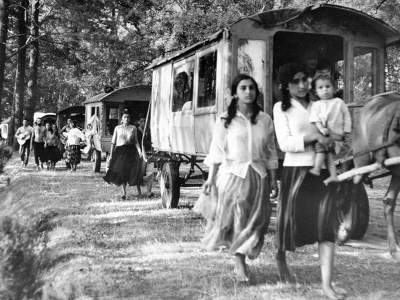History
The situation of the Roma in Poland was much better than in other European countries. Although in the second half of the sixteenth century, were issued against them the Acts of banicyjne (the first was passed in the reign of King Sigismund Augustus in 1557), it is this type of regulation that have not been implemented.
The attitude of the authorities towards the Roma has noticeably deteriorated along with the loss of the independence of the Republic. The invaders tightened the exchange rate against the Roma living in the Polish lands. From 1816 in the Kingdom of Poland the municipal authorities were required to write off the personal data of the Roma in a specially prepared for this purpose registers. The Roma hold a special certificate. In 1844, these rules were made stricter - because of the lack of "legitimacy", the Roma were threatened to be arrested. In 1849, the police determined the cash prizes in the amount of 2 rubles and 85 kopecks for each captured adult Roma and a half of that amount for a child. This marked the beginning of a wave of violence against the Roma by the police and the tsarist administration.
The Roma also did not escape the persecution under the Austrian rule. In 1782, the emperor issued a number of decrees against the Roma. They banned the public use of the Romani language, wearing colorful clothes, and the possession and trade of horses. The Roma were forced to settle.
Regulation adopted anti-Roma when also under Prussian rule. At the end of the nineteenth century, Otto von Bismarck exacerbated some of the discriminatory laws, believing that the Roma should be treated with "particular severity". In 1890, Germany held the conference "Gypsy scum", during which the army was allowed to retain the Roma camps.
In the Second Republic the Roma issue was treated marginally. At that time, they were still arresting the Roma, whose primary reason was to carry out their nomadic lifestyle.
In Poland, the People's Communist authorities decided to finally put an end to the nomadic lifestyle of the Roma. They launched an administrative and repressive apparatus, which led Roma to stop wandering. In 1947, the first forced labour camps in which, inter alia, pelleted nomadic Roma. May 24, 1952 r. The government presidium resolved to "aid the Gypsy population in transition to sedentary life." In September this year, the Citizens conducted so. Action "C", whose aim was clear evidence of Roma migratory return of the documents and the creation of photographic and fingerprint records. In 1964, the share of compulsory settlement and "productivization" was sealed. The centuries-old tradition of Roma wandering slowly faded into history.

References:
- Stowarzyszenia Romów w Polsce, Sytuacja Romów na ziemiach polskich [online], Polska, available at: http://www.stowarzyszenie.romowie.net/czytnik-artykulow/items/82.html
- Portal Krosno24.pl, Cyganie historia i kuktura [online], Polska [2012], available at: http://www.krosno24.pl/kultura.php3?id=5877
